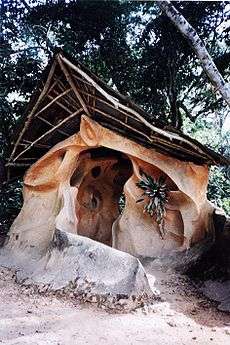Oshun

Oshun (known as Ochún or Oxúm in Latin America) also spelled Ọṣun, is an orisha, a spirit or deity that reflects one of the manifestations of God in the Ifá and Yoruba religions. She is one of the most popular and venerated orishas.[1]
Oshun is a deity of the river and fresh water, luxury and pleasure, sexuality and fertility, and beauty and love.[1][2] She is connected to destiny and divination.[3]
She is the patron saint of the Osun River in Nigeria, which bears her name.[1] Oshun is honored at the Osun-Osogbo Festival a two-week-long annual festival, usually in August, at the Osun-Osogbo Sacred Grove on the banks of the Osun River, Nigeria.[4]
Oshun is syncretized with Our Lady of Charity, patron saint of Cuba, and Our Lady of Aparecida, the patron saint of Brazil.[5] In Trinidad she is associated with St. Philomena[6] and the Hindu deity Ganga Mai or Mother Ganges.[7]
Summary
According to the Ifa Literary Corpus in Ose Otura, Ọṣun was the only female irunmole (primordial) sent to set up the world by Olodumare. The other males that were sent began the work and ignored Ọṣun. Ọṣun gathered the women and protested the blatant disrespect by forming Iyami Aje, a band of women endowed with special power. The men failed miserably and when they inquired to Olodumare as to why they weren't succeeding, Olodumare informed them that nothing can be done with out Ọṣun. Anything they attempt to do without women will fail. The male irunmole hurried to beg Ọṣun to join them. [8]
Oshun is said to have gone to a drum festival one day and to have fallen in love with Shango. Since that day, Shango has been married to Oba, Oya, and Oshun, though Oshun is said to be his principal wife.[9] Other stanzas in the Ifa Literary Corpus say that she was also married to Orunmila, the Orisha of Wisdom and Divination.
Oshun is the orisha of the river. Her devotees leave her perform offerings and ceremonies at bodies of fresh water such as rivers, streams and canals.[10]
Oshun is associated with the colours gold/deep yellow in the diaspora and in Nigeria, white, yellow and green. In Trinidad she's associated with the colour pink.[10]
Violin for Ochun
A violín is a type of musical ceremony in Regla de Ocha performed for Ochún. It includes both European classical music and Cuban popular music. [11]
References
- 1 2 3 Murrell, Nathaniel Samuel (2009). Afro-Caribbean Religions: An Introduction to Their Historical, Cultural, and Sacred Traditions. Temple University Press. ISBN 9781439901755.
- ↑ Coleman, Monica A. (2006). "African American Religion and Gender". In Pinn, Anthony B. African American Religious Cultures. p. 501. ISBN 9781576074701.
- ↑ Monaghan, Monaghan (2014). Encyclopedia of Goddesses and Heroines. New World Library. p. 15. ISBN 9781608682188.
- ↑ Martine, Ife. "A Yoruba Festival Tradition Continues: 50 Incredible Photos Celebrating The River Goddess Oshun". OkayAfrica.com. Retrieved 21 June 2016.
- ↑ Thompson, Robert Farris (1983). Flash of the Spirit. Vintage Books. p. 79.
- ↑ Lum, Kenneth Anthony (2013). Praising His Name In The Dance: Spirit Possession in the Spiritual Baptist Faith and Orisha Work in Trinidad, West Indies. Routledge. p. 123. ISBN 9781136766305.
- ↑ Dabydeen, David; Samaroo, Brinsley (1996). Across the Dark Waters: Ethnicity and Indian Identity in the Caribbean. Macmillan Caribbean. p. 96. ISBN 9780333535080.
- ↑ Kumari, Ayele (2013). Iyanifa: Women of Wisdom. uSA: maat Group. p. 40. ISBN 978-1500492892.
- ↑ Matory, J. Lorand (2005). Sex and the Empire That Is No More: Gender and the Politics of Metaphor in Oyo Yoruba Religion. Berghahn Books. ISBN 9781571813077. Retrieved 21 June 2016.
- 1 2 Stewart, Dianne M . (2006). "Women in African Caribbean Traditions". In Skinner, Rosemary Kelly; et al. Encyclopedia of Women and Religion in North America: Women and religion: methods of study and reflection. Indiana University Press. p. 120. ISBN 9780253346865.
- ↑ A VIOLIN FOR OCHÚN-WITH REGGAETON! By Johnny Frías. Cuba Counterpoints, Nov 2016
Further reading
- Ajiabde, G. Olusola. Negotiating Performance: Osun in the Verbal and Visual Metaphors, Bayreuth, Working Papers, 2005.
- Afolabi, Kayode. Osun Osogbo - Sacred People and Sacred Places, Charleston 2006.
- Badejo, Diedre, Oshun Seegesi: The Elegant Deity of Wealth, Power, and Femininity, Asmara 1996.
- De La Torre, Miguel A., "Dancing with Ochún: Imagining How a Black Goddess Became White," in Black Religion and Aesthetics: Religious Thought and Life in Africa and the African Diaspora, Anthony Pinn, ed., Cambridge University Press, pp. 113–134.
- Fakayode, Fayemi Fatunde, Osun: The Manly Woman, Athelia Henrietta Press 2004.
- Murphy, Joseph M.; Sanford, Mei-Mei. Osun Across the Waters: A Yoruba Goddess in African and the Americas. Bloomington: Indiana University Press, 2001.
- Probst, Peter, Osogbo and the Art of Heritage : Monuments, Deities, and Money. Bloomington: Indiana University Press, 2011.
- Popoola, S. Solagbade, Ikunle Abiyamo: It is on Bent Knees that I gave Birth. Asefin Media Publication, 2007
- Akalatunde, Osunyemi, Ona Agbani: The Ancient Path: Understanding And Implementing The Ways Of Our Ancestors . Createspace, 2005